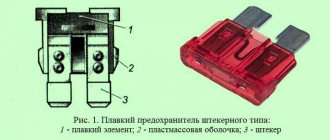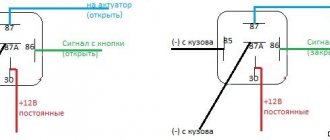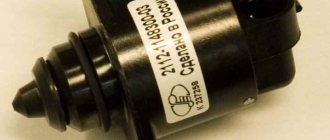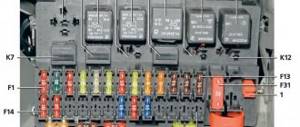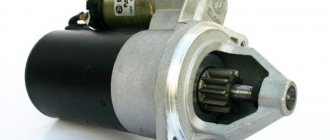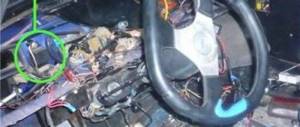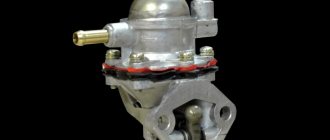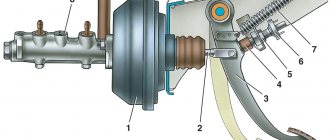Generator voltage regulator relay. Such a complex, at first glance, name refers to a very small component of a car or motorcycle generator, and whose failure can cause a number of problems. For example: undercharging or overcharging of the battery. This can happen for many reasons, but in most cases the culprit of the problem is a failed generator relay (as it is usually called). Let's figure out what a generator relay is, how this component is connected to the vehicle's on-board network, how to check it and, if necessary, replace it.
Basic Concepts
The relay regulator, which is an important part of the on-board electrical network, is responsible for regulating the current generated by the vehicle generator. Due to the operation of the relay, the battery is prevented from overcharging, which is detrimental to it. Those knowledgeable in electrical engineering, cars and motorcycle enthusiasts will notice: according to the description, this is a regular voltage stabilizer! Essentially, that's what he is. But let's understand a little about generators.
In essence, both direct and alternating current generators are electrical machines that convert mechanical energy into electric current. Today, alternators are more common because they do not use current-collecting brushes, which tend to burn or become severely deformed as the device is used. The output voltage of both types of generators depends on the speed at which the magnetic field rotates inside it and on the magnetic force. The so-called excitation winding is initially supplied to excitation current , due to which magnetic induction is induced. The strength of this current must be adjusted. At a certain point, power needs to stop being supplied to the field winding - another point that needs to be monitored. Further, since in alternating current generators the position of the poles “ + ” and “ - ” is constantly changing, the current must be rectified. The diode bridge is responsible for this, but the range of output voltages can be quite wide. And now we can highlight the main tasks of the generator relay regulator:
- Maintain a voltage range ( 13.5 – 14.5 Volts ) in the network of a car or motorcycle, as well as at the terminals of their battery;
- Excitation current adjustment;
- Stopping the power supply from the battery to the field winding.
Essentially, the generator relay “monitors” the output voltage and current that powers the voltage winding. As soon as the output voltage becomes too high, the relay reduces the excitation current. If the situation is reverse and the generator voltage has decreased, the current to the exciting winding should increase. This happens many times, and stabilization lasts a fraction of a second . Thus, the relay ensures the normal operation of the generator, which now provides the optimal voltage for electrical receivers (radio tape recorders, for example), and saves the life of the battery, also preventing its failure due to recharging with too much current.
Purpose of the relay regulator
The generator voltage regulator relay is designed to stabilize the current in the installation. When the engine is operating, the voltage in the vehicle's electrical system must be at the same level. But since the crankshaft rotates at different speeds and the engine speed is not the same, the generator unit produces different voltages. Without adjusting this parameter, malfunctions in the functioning of the electrical equipment and devices of the machine may occur.
Interconnection of car current sources
Any car uses two power sources:
- Battery - required to start the power unit and primary excitation of the generator set. The battery consumes and stores energy when recharging.
- Generator. Designed for power and needed to generate energy regardless of speed. The device allows you to replenish the battery charge when operating at high speeds.
In any electrical network, both nodes must be working. If the DC generator fails, the battery will last no more than two hours. Without a battery, the power unit, which drives the rotor of the generator set, will not start.
The LR West channel talked about electrical faults in Land Rover cars, as well as the relationship between the battery and generators.
Voltage regulator tasks
Tasks performed by an electronic adjustable device:
- change in current value in the excitation winding;
- the ability to withstand a range of 13.5 to 14.5 volts in the electrical network, as well as at the battery terminals;
- turning off the power to the field winding when the power unit is turned off;
- battery charging function.
“People's Auto Channel” spoke in detail about the purpose, as well as the tasks performed by the voltage regulator device in a car.
Types of relay regulators
Modern relay regulators do not use electromagnetic relays as a base - they are completely semiconductor. The use of semiconductors made the device both reliable and very compact, but reduced its maintainability to almost nothing. There are quite a few types of relay-regulators, but one thing is essential: there are no fundamental differences between relays of different types. It is worth distinguishing two types:
- Built-in . Sometimes this type of relay is called a “chocolate bar”. Located inside the generator and combined with the brush assembly;
- Taken out . Attached to the car body.
Spare parts for Mazda 2
Trunk glass (3/5th rear door (lyada)
1.3 ZJ-VE
Spare parts for chevrolet volt
Front brake caliper repair kit 1.4 A14XFL
The housings of all new regulators are non-separable, so getting to the semiconductor “filling” will not be easy. The body can be either polymer or steel. The weak point of the regulators is rather the contacts and wires. The former oxidize over time, and the insulation of the latter may melt or suffer mechanical damage.
Types of relay regulators
There are several types of automotive relay regulators:
- external - this type of relay allows you to increase the maintainability of the generator unit;
- built-in - installed in the rectifier plate or brush assembly;
- changing in minus direction - equipped with an additional cable;
- regulated by plus - characterized by a more economical connection scheme;
- for installation in AC units - the voltage cannot be adjusted when applied to the excitation winding, since it is installed in the generator;
- for direct current devices - relay regulators have the function of cutting off the battery when the engine is not running;
- two-level relays - today they are practically not used; they are adjusted using springs and a lever;
- three-level - equipped with a comparison module circuit, as well as a matching signaling device;
- multi-level - equipped with 3-5 additional resistor elements, as well as a control system;
- transistor samples - not used on modern vehicles;
- relay devices - characterized by more improved feedback;
- relay-transistor - have a universal circuit;
- microprocessor relays - characterized by their small size, as well as the ability to smoothly change the lower or upper operating threshold;
- integral - installed in brush holders, so they change when they wear out.
DC relay regulators
In such units, the connection diagram looks more complex. If the car is stationary and the engine is not running, the generator unit must be disconnected from the battery.
When performing a relay test, you must ensure that you have three options:
- battery cut-off when the vehicle is parked;
- limitation of the maximum current parameter at the unit output;
- possibility of changing the voltage parameter for the winding.
AC relay regulators
Such devices are characterized by a more simplified testing scheme. The car owner needs to diagnose the voltage level on the excitation winding, as well as at the output of the unit.
If an alternating current generator is installed in the car, then it will not be possible to start the engine “from a pusher”, unlike a direct current unit.
Built-in and external relay regulators
The procedure for changing the voltage value is carried out by the device at a specific installation location. Accordingly, the built-in regulators influence the generator unit. And the external type of relay is not connected to it and can be connected to the ignition coil, then its work will only be aimed at changing the voltage in this area. Therefore, before performing diagnostics, the car owner must make sure that the part is connected correctly.
The “Sovering TVi” channel spoke in detail about the purpose and operating principle of this type of device.
Two-level
The operating principle of such devices is as follows:
- Current flows through the relay.
- As a result of the formation of a magnetic field, the lever is attracted.
- A spring with a specific force is used as a comparing element.
- When the voltage increases, the contact elements open.
- Less current is supplied to the field winding.
In VAZ cars, mechanical two-level devices were previously used for regulation. The main disadvantage was the rapid wear of structural components. Therefore, instead of mechanical ones, electronic regulators began to be installed on these machine models.
These parts were based on:
- voltage dividers, which were assembled from resistor elements;
- A zener diode was used as a reference part.
Due to the complex wiring diagram and ineffective voltage level control, this type of device has become less common.
Three-level
This type of regulators, like multi-level ones, are more advanced:
- The voltage is supplied from the generator device to a special circuit and passes through a divider.
- The received data is processed, the actual voltage level is compared with the minimum and maximum values.
- The mismatch pulse changes the current parameter that is supplied to the excitation winding.
Three-level devices with frequency modulation do not have resistance, but the frequency of operation of the electronic key in them is higher. Special logic circuits are used for control.
Control by minus and plus
The circuits for the negative and positive contacts differ only in connection:
- when installed in the positive gap, one brush is connected to ground, and the second goes to the relay terminal;
- if the relay is installed in the minus gap, then one brush element must be connected to the plus, and the second - directly to the relay.
But in the second case, another cable will appear. This is due to the fact that these relay modules belong to the class of active type devices. For its operation, a separate power supply is required, so the plus is connected individually.
Photo gallery “Types of generator voltage regulator relays”
This section presents photos of some types of devices.
Remote device type
Built-in regulator
Transistor-relay type
Integral device
Device for DC generator
AC control device
Two-level device type
Three-level control device
Reasons for failure
Relay regulators do not fail very often, but if car enthusiasts are unlucky with this, they should not ignore the problem . Here are the main reasons for device failure:
- An interturn short circuit has occurred in the excitation winding. This is the most common reason why a relay has to be replaced. It is worth noting here that even a new relay may not last long. If even a new device quickly fails, it is worth removing the generator and testing it;
- Diode breakdown. This doesn't happen very often. When diodes breakdown, the generator overheats;
- Reversal of polarity in the battery. If this problem persists for a long time, the rectifier diodes fail;
- A short circuit occurred at the control terminal of the generator relay-regulator;
- Destruction of brushes.
Also, the reason for relay failure is its natural wear and tear . As a rule, the device lasts a very long time, but even the most reliable automotive electronics, sealed in a sealed case, have to be replaced every 6-8 years. If the relay-regulator is faulty, not only the battery, but even the electronic unit of the car and the generator itself may fail.
Diagnostics of an automobile relay-regulator
First, you need to decide whether checking the relay is necessary at all. First of all, pay attention to incorrect charging of the battery:
- Overcharging is observed . The electrolyte begins to boil away, and the acid solution may fall on body parts;
- Undercharging is observed . The battery charge is constantly low, as a result of which the engine may not start, and the optics may remain incandescent.
If you observe any of the above, you need to get a tester and start checking the relay regulator. In short, any voltage deviation from the maximum (14.5, in rare cars as much as 14.8 Volts) or minimum (12.8 Volts) at the corresponding speeds indicates the need to replace the relay regulator. Before diagnosing, it is worth measuring the voltage at the terminals of the car battery - normally it is 12.8 Volts.
If the vehicle uses a built-in relay, you need to do the following:
- Remove the brush assembly and, if necessary, select new brushes. Brushes less than 5 millimeters are considered short;
- Take the power source. A power supply or charger that allows you to regulate the voltage to at least 16 Volts . Connect the negative wire of the source to the corresponding terminal of the regulator;
- The “positive” wire of the power source is connected to the corresponding terminal of the relay regulator;
- Connect a 10-watt test lamp to the brushes. If it is not available, an LED will do;
- Apply power from the source to the relay, gradually increasing the voltage. As soon as it exceeds 14.5 or 14.8 Volts (exceptional case), the lamp/LED should go out.
If the relay regulator does not pass the test (the control device does not go out), it is definitely worth changing. If you ignore the problem, the battery will be overcharged on a constant basis, which will eventually lead to its failure. In the case of a built-in relay, checking will become even easier:
- Connect the tester probes to the relay terminals;
- Set the multimeter to 20 Volts ;
- Start the engine and check the voltage indicator - it should be minimal (about 12.8 Volts);
- Increase engine speed. Voltage readings should increase smoothly;
- When the engine is at 3500 rpm , monitor changes in voltage readings. They must fall into the range of 14-14.5 Volts. In some cars the maximum is 14.8 volts.
If you observed serious deviations or, on the contrary, constant voltage regardless of the speed, the relay regulator is clearly faulty. We strongly recommend that even after these checks, you check the regulator terminals once again - oxides and deposits can interfere with correct diagnostics of the device. After cleaning, the diagnosis should be repeated.
Operating principle of the regulator relay
Thanks to built-in resistors and special circuits, the relay is able to compare the amount of voltage generated by the generator. After which, too high a value leads to the relay being turned off, so as not to overcharge the battery and damage electrical appliances connected to the on-board network.
Any malfunctions lead to precisely these consequences: the battery becomes faulty or the operating budget increases sharply.
Summer/winter switch
Regardless of the season and air temperature, the operation of the generator is always stable. As soon as its pulley begins to rotate, electric current is generated by default. However, in winter the insides of the battery freeze, and it replenishes the charge much worse than in summer.
The summer/winter switches are either on the body of the voltage regulator, or the corresponding connectors are marked with this designation, which you need to find and connect the wiring to them depending on the season.
There is nothing unusual in this switch, these are just rough settings of the regulator relay, which allows you to increase the voltage at the battery terminals to 15 V.
Connection to the generator's on-board network
If, when replacing a generator, you connect a new device yourself, you need to take into account the following nuances:
- First you should check the integrity and reliability of the contact of the wire from the car body to the generator housing
- then you can connect terminal B of the regulator relay with the “+” of the generator
- Instead of “twists” that begin to heat up after 1–2 years of operation, it is better to use soldering of wires
- the factory wire must be replaced with a cable with a minimum cross-section of 6 mm2 if, instead of a standard generator, an electrical appliance rated for a current of more than 60 A is installed
- The ammeter in the generator/battery circuit shows which power source is currently higher in the on-board network
Selecting a new generator relay
Selecting a new relay regulator is quite simple. It doesn’t even make much sense for a car enthusiast to understand what specific type of device it is. What he really should take advantage of are the electronic catalogs of advanced online stores - such stores have their own cross-code database and allow you to select both the original relay and its analogues. The search can be carried out using the following parameters:
- Vehicle VIN code;
- Code of an already installed relay. Painted or embossed on the device body;
- Vehicle data. We are talking about the make and model, the year of manufacture, and engine parameters.
The easiest way to search is by the code of the existing relay, since the device is easy to get to and it is always marked. By the way, it may be difficult to select analogues for relay regulators of the latest car models from German automakers . The device may have a program-controlled microprocessor in its element base (introduced by BMW and Audi ) and, as a rule, is produced only under the brand of the automaker - there are no analogues on the spare parts market.
Excursion to the manufacturers
If you are selecting a relay regulator for a domestic car, you can find products from many companies. If we are talking about selecting a relay for a foreign car, there will not be so many manufacturing companies. In fact, their products are offered by packers - there are few small manufacturers of generator relays. You should pay attention first of all to relays from these companies:
- Bosch (Germany);
- Valeo (France);
- Cargo (Denmark);
- Huco (Germany).
The products of all the above brands with the exception of Cargo are counterfeited extremely often . But counterfeit relays from a Danish company are almost never found, although car enthusiasts should be extremely careful when purchasing spare parts from this manufacturer and ensure the authenticity of the product.
Very good electrics can be found in the catalogs of companies such as Mobiltron (Taiwan), ERA (Italy). There are quite a lot of negative reviews from car enthusiasts about the products of these companies, so a potential buyer should think about whether he is ready to play the “lottery” - the quality of spare parts from these companies can vary from delivery to delivery. WAI spare parts (USA) are very good, but they are counterfeited and their quality may vary depending on the country of production and the market targeted by the American company.
Conclusion
The voltage regulator relay is one of the smallest and most inconspicuous components of the electronics of urban vehicles, but at the same time, its role is very large. Without adjusting the excitation voltage and current, both the generator and the electronics powered by it would stop working normally or fail completely. What, however, can really happen if a malfunctioning regulator is not replaced in time. Fortunately, many companies offer relay regulators today, so the car enthusiast will certainly have plenty to choose from.
Remote controller
This often happens to drivers. The brushes of the generating device burn out. The regulator is built in along with the brushes. We have to change everything together. And here’s some advice from experts: it’s better to install an external regulator than a built-in one. The models released recently have not been praised very much.
Okay, do you think I’ll install an external one, but how do I connect it? It turns out that there is a convenient scheme that makes it easy to carry out all this modernization.
Some important points:
- do not confuse the chips on the regulator numbered 67 and 15 (the first should be connected to the generating device, and the second should go to the fuses);
This is what the connection diagram looks like
Connection diagram for external and built-in relays
In the lower photo we see a diagram that shows the connection of the already built-in regulator relay.
It is suitable for connecting to “fives”, “sevens”, VAZ 2104, if the PG is installed from a VAZ “kopek”. As you can see, the remote-type regulator relay is connected via two terminals. Pin 15 goes to the fuse.
The second pin 67 is connected to the generator. The wire is connected to the brush chip.
Also, the remote-type relay must be connected to ground - any part of the body.
A relay is nothing more than a switch that serves to close and disconnect individual zones of an electrical circuit that occur at specific electrical values. A machine relay is otherwise called a load voltage switch, and this is 100 percent true. When the power supply unit, fan or starter consumes more current than necessary, the relay trips.
What is a voltage regulator?
The relay consists of an electric type magnet, an armature and a switch. In this case, the electromagnet is a cable twisted around an inductor with a magnetic rod, and the armature is a special plate that controls the contacts.
As soon as electrical voltage passes through the magnet winding, an electric field is created. A special pusher presses the armature against the core and, thereby, the contacts switch.
Attention. There are two types of relays used on VAZ cars. This is a non-contact relay-regulator and MER (electric). It is the diagram of the last relay that is shown in the picture below.
Article on the topic: Ways to reduce fuel consumption in winter
The non-contact relay or NERR is a fairly new unit that does not require any additional adjustments or regulation. As for the MED, this is an old-style device, the production of which has currently been suspended.
So, the BRN or built-in regulator is a device consisting of a microcircuit, a transistor and a housing with brushes. If the built-in regulator fails, it is replaced with a new one, or an external one is installed.
The external regulator is easy to install if you strictly follow the instructions.
Modernization involves dismantling and disassembling the generating device.


